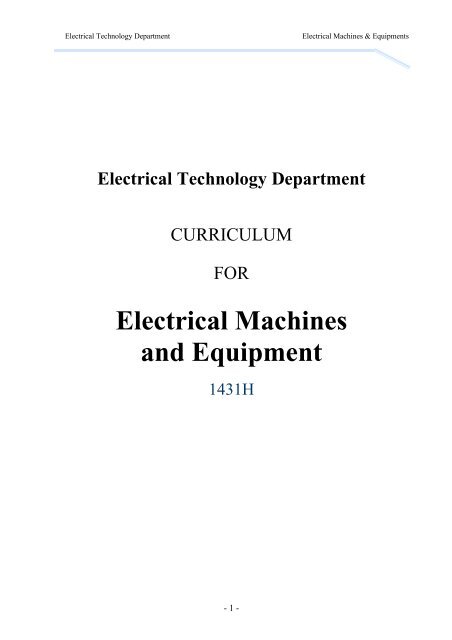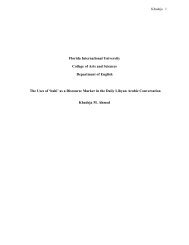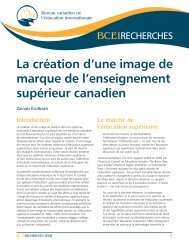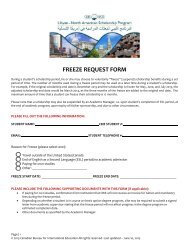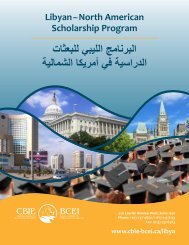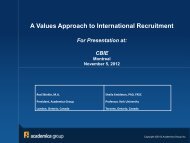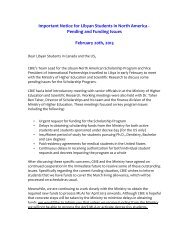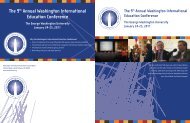Electrical Machines and Equipment
Electrical Machines and Equipment
Electrical Machines and Equipment
Create successful ePaper yourself
Turn your PDF publications into a flip-book with our unique Google optimized e-Paper software.
<strong>Electrical</strong> Technology Department<strong>Electrical</strong> <strong>Machines</strong> & <strong>Equipment</strong>s Basic Electrostatics Batteries Principles of DC Circuits DC Circuits Analysis Electromagnetism Magnetic Circuits- 7 -
<strong>Electrical</strong> Technology Department<strong>Electrical</strong> <strong>Machines</strong> & <strong>Equipment</strong>sDetailed Theoretical ContentsHours Contents Related Tasks81-ElectrostaticsElectric charge Electric charge. Coulomb's law. Force between two charges. Electric field Electric potential. Potential difference.Capacitors Capacitance of an isolated ball. Capacitance of an earthed ball capacitor. Capacitance of a parallel plate capacitor. Series <strong>and</strong> parallel connections of capacitors. Energy stored in capacitors.Basic Knowledge62-Batteries Primary cells. Secondary cells. Definitions of the capacity of the battery <strong>and</strong> the chargingcurrent. Charging <strong>and</strong> discharging curves. Connection of cells in series <strong>and</strong> parallel.Basic KnowledgeA4, B3, B4, B6,B7, B8, B9, C2,C3, C6, C7, D5,D9, E3, E4, E5, F3,F5, H2, H11, J5- 8 -
<strong>Electrical</strong> Technology Department<strong>Electrical</strong> <strong>Machines</strong> & <strong>Equipment</strong>sDetailed Theoretical ContentsHours Contents Related Tasks3-DC circuits<strong>Electrical</strong> Quantities Quantity of charge. Current <strong>and</strong> current intensity. DC voltage <strong>and</strong> current Resistance <strong>and</strong> resistors. Ohm's lawDifferentiation between conductors <strong>and</strong> semi-conductors, <strong>and</strong>insulators with respect to properties <strong>and</strong> atomic construction. Metallic conductors. Electrolytic conductors. Semi conductors. Insulators.10Factors affecting conductor resistance. Conductor length, cross-sectional area, <strong>and</strong> type of material. Effect of temperature on resistance. Positive <strong>and</strong> negative temperature coefficient of resistance. Calculation of homogenous conductor resistance.Methods of connecting resistors. Series connection of resistors. Parallel connection of resistors. Series-parallel connection of resistors. Calculation of resistances connected in series-parallelconnections.Kirchoff's laws: Kirchoff's current laws. Kirchoff's voltage laws.Simple circuit calculations. Series connection. Voltage divider rule. Parallel connection. Current divider rule. Series parallel connection Star or delta connection. Star or delta transformations. Power dissipated in resistors.Basic KnowledgeA4,A8, B3, B4, B6,B7, B8, B9, C2,C3, C6, C7, D5,D9, E3, E4,E5,F1,F2, F3, F5,H2, H11, J5- 9 -
<strong>Electrical</strong> Technology Department<strong>Electrical</strong> <strong>Machines</strong> & <strong>Equipment</strong>sDetailed Theoretical ContentsHours Contents Related Tasks84-DC circuit analysis: Methods of DC circuit analysis. Kirchoff's current <strong>and</strong> voltage laws. Mesh current method. Node voltage method. Superposition method.Note: not more than two equations.Basic KnowledgeA4,A8, B3, B4, B6,B7, B8, B9, C2,C3, C6, C7, D5,D9, E3, E4,E5,F1,F2, F3, F5,H2, H11, J5105- Electromagnetism: Natural <strong>and</strong> magnetic fields. Magnetic field due to current carrying conductor <strong>and</strong> theright h<strong>and</strong> rule. Magnetic field due to a coil. Magnetic field density, magnetic field intensity, <strong>and</strong>permeability. Mechanical force acting on a conductor carrying DC currentin a magnetic field, <strong>and</strong> factors affecting this force. Direction of force acting on a conductor carrying DC current Elector-magnetic force generated in a conductor movingvertically to a magnetic field. Direction of EMF generated in a conductor moving verticallyto a magnetic field. Self <strong>and</strong> mutual induction. Lenz's lawBasic Knowledge106- Magnetic Circuits: Magnetic reluctance <strong>and</strong> the factors affecting it. Electro-magnetic force. Ohm's law for the magnetic circuit. Comparison between electric <strong>and</strong> magnetic circuits. Classification of magnetic materials according to theirmagnetic properties. Magnetization curve for some magnetic materials. Kirchoff's laws for magnetic circuits. Application using simple magnetic circuits.Basic Knowledge- 10 -
<strong>Electrical</strong> Technology Department<strong>Electrical</strong> <strong>Machines</strong> & <strong>Equipment</strong>sReferences <strong>Electrical</strong> Technology, Edward Hughes Introductory Circuit Analysis, Robert L. Boylestad, 2000 Principles of Electric circuits, Thomas L. Floyd, 1999 Fundamentals of Electric Circuits, Charles K. Alex<strong>and</strong>er, N.O. Sadiaka, 2000 Electric Circuits, Joseph Edminister, Mahmood Nahoi, 1997- 11 -
<strong>Electrical</strong> Technology Department<strong>Electrical</strong> <strong>Machines</strong> & <strong>Equipment</strong>s<strong>Electrical</strong> <strong>Machines</strong>Department <strong>Electrical</strong> Technology Major& <strong>Equipment</strong>Course Name Electro-mechanical W/S Course Code ELT 179PrerequisitesNoneCourse Description:This practical course prepares the trainees to usemechanical tools, especially those used in electrical works. Thetrainees are introduced to the fundamentals of electricalinstallations, as well as the regulations <strong>and</strong> symbols used inelectrical installations. In addition, the trainees are also taughthow to apply electrical installations to domestic <strong>and</strong> industrialbuildings, <strong>and</strong> diagnosis <strong>and</strong> fault correction.Trimester 2Credit Hours 4ContactHours(h/w)LP 8TGeneral objective of the course:The course aims to enable the trainees to use mechanical tools in a professional way, <strong>and</strong> to befamiliar with the electrical regulation of domestic <strong>and</strong> industrial installations. The trainees are alsotaught to install <strong>and</strong> put into operation simple domestic <strong>and</strong> industrial installationsBehavioral Objectives:The trainees should be able to:1. Perform mechanical <strong>and</strong> electrical operations.2. Read <strong>and</strong> draw simple electrical layouts <strong>and</strong> their symbols.3. Be familiar with the electrical regulation of domestic <strong>and</strong> industrial installations.4. Install, put into operation, test <strong>and</strong> carry out trouble-shooting of domesticinstallations.5. Find faults in simple electrical installations <strong>and</strong> clear the faults.Contents (Practical): Basic mechanical tools <strong>and</strong> mechanical skills. Mechanical <strong>and</strong> electrical work to build <strong>and</strong> assemble a small transformer. Fundamentals of electrical installation. <strong>Electrical</strong> installations for domestic <strong>and</strong> industrial buildings.- 12 -
<strong>Electrical</strong> Technology Department<strong>Electrical</strong> <strong>Machines</strong> & <strong>Equipment</strong>sDetailed Practical ContentsHours Contents Related Tasks1- Basic mechanical tools <strong>and</strong> mechanical skills:16 Using mechanical h<strong>and</strong> tools. Using electrical h<strong>and</strong> machines (electric drills, electric saws,etc ). Measuring, laying out, punching, drilling, sawing, filing,cutting thread, <strong>and</strong> preparing fitting. Carrying out simple mechanical operations.Basic knowledgeA2, A3, A6, A8,B8482- Mechanical <strong>and</strong> electrical work to build <strong>and</strong> assemble asmall transformer:Preparing of lamination Measuring <strong>and</strong> laying out material with well chosen tools. Selecting a suitable file. Choosing the proper tapping drill sizes. Producing countersinks for screw heads with a help of benchdrillsPreparing coil forms Measuring <strong>and</strong> laying out material with well chosen tools. Fixing <strong>and</strong> filing the work piece. Machining <strong>and</strong> drilling the coil form in a proper way.Assembling the coil forms. Selecting the proper wire size. Determining the number of turns. Winding the primary <strong>and</strong> secondary coils <strong>and</strong> isolate them. Checking the coil for short circuits between layers.Manufacturing the transformer case Measuring <strong>and</strong> laying out materials with well chosen tools. Fixing <strong>and</strong> filing the case.Assembling the transformer. Fastening the transformer <strong>and</strong> coils inside the case. Installing ON/OFF switch, indicator lamp, voltmeter, <strong>and</strong>connecting terminals. Testing the transformer.Basic knowledgeA2, A3, A6, A8,D3, D4, I3H7, H8, H9, I5, I7- 13 -
<strong>Electrical</strong> Technology Department<strong>Electrical</strong> <strong>Machines</strong> & <strong>Equipment</strong>sDetailed Practical ContentsHours Contents Related Tasks3- Fundamentals of electrical installation:16 Components of electrical installations <strong>and</strong> their symbols. Wire types <strong>and</strong> colors. Wire trimming, soldering, <strong>and</strong> connecting by screw. Power calculations <strong>and</strong> balanced distribution in the threephases Cables <strong>and</strong> conductor size selections.Basic knowledgeA8, F1, F3, F4, I5,I7, I10244- <strong>Electrical</strong> installations for domestic <strong>and</strong> industrial buildings: Drawing a circuit diagram with symbols. Determining the place of the distribution panel. Fixing the distribution panel. Load power calculations <strong>and</strong> proper cable selection. Determining conduit size (cross section). Determining conduit paths. Fixing the conduits. Pulling the cable inside the conduit. Circuit breaker rating <strong>and</strong> selection. Circuit breaker installation. Making sure that the earth wire is connected. Energizing the circuit <strong>and</strong> testing the circuit operation.Basic knowledgeI4, I5, I7, I10, I11References Top 2 <strong>and</strong> 4: Electric Power Engineering Proficiency Course,Deutsche Gesellschaft Fur Technische Zusammenarbeit (GTZ)- 14 -
<strong>Electrical</strong> Technology Department<strong>Electrical</strong> <strong>Machines</strong> & <strong>Equipment</strong>s<strong>Electrical</strong> <strong>Machines</strong>Department <strong>Electrical</strong> Technology Major& <strong>Equipment</strong>Course Name Electric Circuits-II Course Code ELT 107PrerequisitesElectric Circuits-ICourse Description:Trimester 3This course describes two main topics: Single phase circuitsCredit Hours 3 Three phase circuits.Contact L 3The course explains the fundamentals of AC circuits, <strong>and</strong>Hours Penables the trainees to analyze single <strong>and</strong> three phase circuits.(h/w) T 1General objective of the course:The aim of the course is to enable the trainees to underst<strong>and</strong> <strong>and</strong> analyze single <strong>and</strong> three phaseAC circuits.Behavioral Objectives:The trainees should be able to:11. Underst<strong>and</strong> the fundamentals of alternating current.12. Explain the characteristics of AC current.13. Underst<strong>and</strong> the definitions of alternating current.14. Underst<strong>and</strong> the different connections of impedances.15. Know the phase angle between voltage <strong>and</strong> current in resistive, inductive, <strong>and</strong>capacitive impedances.16. Calculate the impedance.17. Define the terms resistance, inductive reactance, capacitive reactance, <strong>and</strong>impedance.18. Know the phase angle between voltage <strong>and</strong> current in resistive, inductive, <strong>and</strong>capacitive impedances.19. Calculate the impedance.20. Underst<strong>and</strong> the meaning of the power factor.21. Differentiate between series <strong>and</strong> parallel connections in AC circuits.22. Apply voltage <strong>and</strong> current divider rules.23. Discriminate between resistive, capacitive, <strong>and</strong> inductive loads.24. Underst<strong>and</strong> resonance in AC circuits.25. Underst<strong>and</strong> the difference between apparent, active, <strong>and</strong> reactive power.26. Describe three phase systems.27. Explain what is meant by phase sequence.28. Differentiate between Star <strong>and</strong> Delta connections.29. Recognize the relations between line <strong>and</strong> phase quantities.30. Use two watt-meters to measure three phase power.- 15 -
<strong>Electrical</strong> Technology Department<strong>Electrical</strong> <strong>Machines</strong> & <strong>Equipment</strong>sContents (Theoretical): Fundamentals of AC circuits <strong>and</strong> their Analysis Three-phase Circuits <strong>and</strong> their Analysis- 16 -
<strong>Electrical</strong> Technology Department<strong>Electrical</strong> <strong>Machines</strong> & <strong>Equipment</strong>sDetailed Theoretical ContentsHours Contents Related Tasks321. Fundamentals of AC circuits <strong>and</strong> their analysisAlternating current Definition of AC current. Generation of AC voltage. Sinusoidal alternating current. Waveform, frequency, <strong>and</strong> periodic time. Instantaneous value. RMS value of AC voltage <strong>and</strong> current. Average value of AC voltage <strong>and</strong> current. Peak <strong>and</strong> form factors. Phasor representation of sinusoidal waveforms. Phasor algebra. Addition <strong>and</strong> subtraction of phasor quantities. Multiplication <strong>and</strong> division of phasor quantities.Resistance, inductive, <strong>and</strong> capacitive reactance’s Resistance in AC circuits. Inductive reactance in AC circuits. Capacitive reactance in AC circuits. Phasor diagram of restive, inductive <strong>and</strong> capacitiveloads. Ohm's law in AC circuits. Series connection. Voltage divider rule. Resonance in series connected circuits. Parallel connection. Current divider rule. Resonance in parallel connected circuits. Series/Parallel connections. Application of Kirchoff's laws to simple circuits.Work <strong>and</strong> power in single phase AC circuits. Apparent power. Active power. Reactive power. Power triangle. Power factor. Power measurement in single phase circuits.Basic KnowledgeA4, B3, B4, B6,B7, B8, B9, C2,C3, C6, C7, D5,D9, E3, E4, E5, F3,F5, H2, H11, J5- 17 -
<strong>Electrical</strong> Technology Department<strong>Electrical</strong> <strong>Machines</strong> & <strong>Equipment</strong>sDetailed Theoretical ContentsHours Contents Related Tasks202. Three phase AC circuits <strong>and</strong> their analysis Description of three phase systems. Generation of three phase voltages. Phase sequence. Representation of three phase quantities. Star <strong>and</strong> Delta connections. Relation between line <strong>and</strong> phase quantities in case ofStar <strong>and</strong> Delta connections. Conversion from Star to Delta connections <strong>and</strong> viceversa. Power in balanced three phase circuits. Two watt-meters method of measuring power.Basic KnowledgeA4, B3, B4, B6,B7, B8, B9, C2,C3, C6, C7, D5,D9, E3, E4, E5, F3,F5, H2, H11, J5References Electric Circuits, Joseph Edminister, Mahmood Nahoi, 1997 <strong>Electrical</strong> Technology, Edward Hughas Introductory Circuit Analysis, Robert L. Boylestad, 2000 Principles of Electric circuits, Thomas L. Floyd, 1999 Fundamentals of Electric Circuits, Charles K. Alex<strong>and</strong>er, N.O. Sadiaka, 2000 Electric Circuits, Joseph Edminister, Mahmood Nahoi, 1997אאאKKאKא אאא- 18 -
<strong>Electrical</strong> Technology Department<strong>Electrical</strong> <strong>Machines</strong> & <strong>Equipment</strong>s<strong>Electrical</strong> <strong>Machines</strong>Department <strong>Electrical</strong> Technology Major& <strong>Equipment</strong><strong>Electrical</strong> Instruments &Course NameMeasurementsCourse Code ELT 103PrerequisitesElectric Circuits-ICourse Description:This practical course introduces the bases of electricalmeasuring devices. It provides the trainees with the basicknowledge required to use electrical measuring instruments.This is done by teaching the theoretical component <strong>and</strong>executing the necessary experiments in the laboratory.Trimester 3Credit Hours 2ContactHours(h/w)LP 4TGeneral objective of the course:The course aims to enable the trainees to underst<strong>and</strong> the fundamentals of electricalmeasurements <strong>and</strong> measuring instruments. It also enables the trainee to use the different measuringinstruments efficiently.Behavioral Objectives:The trainees should be able to:1. Identify the construction of the different measuring instruments.2. Use the different measuring instruments.3. Read correctly the different measuring instruments.4. Identify the construction <strong>and</strong> the connections of the watt-meters <strong>and</strong> KWHmeters5. Measure power using the two watt-meter method in three phase circuits.6. Identify the construction of the oscilloscope7. Use the oscilloscope as a measuring device8. Identify the construction of digital meters.9. Measure electrical quantities using digital meters.10. Use Wheatstone <strong>and</strong> Maxwell bridges in measurements.11. Identify the construction of potential <strong>and</strong> current transformers (P.T. & C.T.).12. Use the P.T. <strong>and</strong> C.T. in measurements.13. Write reports about the work completed.- 19 -
<strong>Electrical</strong> Technology Department<strong>Electrical</strong> <strong>Machines</strong> & <strong>Equipment</strong>sContents (Practical): Measurements using Moving Coil Instruments Measurements using Moving Iron Instruments Measurements using Digital Meters Measurements using Oscilloscopes Measurements using Wheatstone <strong>and</strong> Maxwell Bridges <strong>Electrical</strong> Power Measurements Measurements using P.T <strong>and</strong> C.T. <strong>Electrical</strong> Energy Measurements- 20 -
<strong>Electrical</strong> Technology Department<strong>Electrical</strong> <strong>Machines</strong> & <strong>Equipment</strong>sDetailed Practical ContentsHours Contents Related Tasks161- Measurements Using Moving Coil Instruments: Construction Using the moving coil instruments to measure the DC <strong>and</strong>AC quantities Measuring the current Internal resistance Increasing the range for current measurement. Measuring the voltage Increasing the range for voltage measurements. Measuring the resistance using moving coil instrument.Basic knowledgeB2, B6 ,F9, C6642- Measurements using moving iron instruments: Construction Using the moving iron instruments to measure the DC <strong>and</strong>AC quantities. Measuring the current. Measuring the voltage.3- Measurements using digital meters: Measuring the voltage using digital meters. Measuring the current using digital meters. Measuring the resistance using digital meters. Calibration of instruments.Basic knowledgeB2, B6 ,F9, C6Basic knowledgeB2, B6 ,F9, C644- Measurements using oscilloscopes: DC voltage measurement. Using oscilloscope to study AC current characteristics.¯ Measuring the peak <strong>and</strong> calculation of RMS value.¯ Measuring the frequency <strong>and</strong> periodic time. DC <strong>and</strong> AC currents measurements. Measuring the phase shift.Basic knowledgeB2, B6 ,F9, C6- 21 -
<strong>Electrical</strong> Technology Department<strong>Electrical</strong> <strong>Machines</strong> & <strong>Equipment</strong>sDetailed Practical ContentsHours Contents Related Tasks45- Measurements using Wheatstone <strong>and</strong> Maxwell Bridges: Wheatstone bridge. Measuring resistance using a Wheatstone Bridge. Maxwell Bridge. Measuring the impedance using a Maxwell Bridge.Basic knowledgeB2, B6 ,F9, C68466- <strong>Electrical</strong> power measurements: Wattmeter. Power measurements in DC circuits¯ Measuring power using the voltage <strong>and</strong> the current.¯ Measuring power using wattmeter Measuring power in single phase circuits¯ Comparing the active power measured by wattmeter withthat measured using voltmeter <strong>and</strong> ammeter.¯ Power factor measurements for resistive, inductive <strong>and</strong>capacitive loads. Measuring power in three phase circuits¯ Measuring the power for resistive, inductive <strong>and</strong> capacitiveloads using three watt meters.¯ Measuring the power for resistive, inductive <strong>and</strong> capacitiveloads using two watt meters¯ Reactive Power measurements.7- Measurements using P.Ts <strong>and</strong> C.Ts Measuring current using C.T. Measuring voltage using P.T. Power measurements using C.T. <strong>and</strong> P.T.8- Measurements using P.Ts <strong>and</strong> C.Ts KWH meters.¯ Measuring electrical energy using three phase KWH meter.¯ Measuring electrical energy using three phase KWH meter<strong>and</strong> C.Ts.¯ Measuring electrical energy using three phase KWH meter<strong>and</strong> C.Ts. <strong>and</strong> P.Ts.Basic knowledgeB2, B6 ,F9, C6Basic knowledgeB2, B6 ,F9, C6Basic knowledgeB2, B6 ,F9, C6- 22 -
<strong>Electrical</strong> Technology Department<strong>Electrical</strong> <strong>Machines</strong> & <strong>Equipment</strong>sReferences <strong>Electrical</strong> Technology, Edwards Hughas Introductory Circuit Analysis, Robert L. Boylestetad, 2000 Principles of Electric Circuits, Thomas L. Floyd, 1999 Fundamentals of Electric Circuits, Charles K. Alex<strong>and</strong>er, N.O.Sadika, 2000 Electric Circuits, Joseph Edminister, Mahmood Nhoi, 1997- 23 -
<strong>Electrical</strong> Technology Department<strong>Electrical</strong> <strong>Machines</strong> & <strong>Equipment</strong>s<strong>Electrical</strong> <strong>Machines</strong>Department <strong>Electrical</strong> Technology Major& <strong>Equipment</strong>Course Name Technical <strong>Electrical</strong> Drawing Course Code ELT 108PrerequisitesNoneCourse Description:The course describes the electrical <strong>and</strong> electronic symbols,<strong>and</strong> the wiring diagrams for residential <strong>and</strong> industrialinstallations.The course also includes the connection diagrams ofcontrol <strong>and</strong> protection circuits.Computer programs may be used to draw such circuits <strong>and</strong>diagrams.Trimester 1 2 3 4Credit Hours 2ContactHours(h/w)L 1P 2General objective of the course:The course aims to introduce the trainees to the basics of technical electrical drawing to enablethem to read layouts of electrical installations, <strong>and</strong> control <strong>and</strong> protection circuit diagrams.Behavioral Objectives:The trainees should be able to:1. Identify electrical <strong>and</strong> electronic symbols.2. Identify the classifications of electrical circuits <strong>and</strong> layouts.3. Read electrical circuits <strong>and</strong> installation layouts.4. Read <strong>and</strong> draw control <strong>and</strong> protection circuits5. Draw single line <strong>and</strong> execution diagrams for domestic installations.6. Draw single line <strong>and</strong> execution diagrams of industrial installations.7. Draw the equivalent circuits for the different types of DC machines.8. Draw the equivalent circuits for the different types of three phase synchronous<strong>and</strong> asynchronous machines.9. Draw circuit diagrams for the different methods of starting of DC <strong>and</strong> ACmachines.10. Draw circuit diagrams for the different methods of speed control of DC <strong>and</strong> ACmachines.11. Draw single line diagrams for electrical networks.12. Draw wiring diagrams for the protection circuits of the elements of an electricalnetwork.T- 24 -
<strong>Electrical</strong> Technology Department<strong>Electrical</strong> <strong>Machines</strong> & <strong>Equipment</strong>sContents (Practical): Elements <strong>and</strong> Symbols of <strong>Electrical</strong> Circuits Single Line <strong>and</strong> Execution Diagrams for Domestic Installations Single Line <strong>and</strong> Execution Diagrams for Industrial Installations <strong>and</strong> theirdistribution networks Connection Diagrams for <strong>Electrical</strong> <strong>Machines</strong> <strong>and</strong> <strong>Equipment</strong> Connection Diagrams for the Methods of Starting <strong>and</strong> Speed Control of<strong>Electrical</strong> Motors Layouts of Power System Networks <strong>and</strong> their Protection Schemes- 25 -
<strong>Electrical</strong> Technology Department<strong>Electrical</strong> <strong>Machines</strong> & <strong>Equipment</strong>sDetailed Practical ContentsHours Contents Related Tasks1- Elements <strong>and</strong> symbols of electrical circuits:9 Symbols of the basic elements.Voltage <strong>and</strong> current sources, resistors, inductors, capacitors,switches, <strong>and</strong> measuring instruments. Symbols of power electronic elements:Diodes, transistors, diac, thyistors, triac MOSFET,.etc. Symbols of control <strong>and</strong> protection circuit elementsContactors, relays, circuit breakers, timers, etc. <strong>Electrical</strong> machines symbols:DC & AC machines <strong>and</strong> transformers.Basic knowledgeI2, E2, C2,E1, H1, I262-Single line <strong>and</strong> execution diagrams for domestic installations: Schematic diagram for domestic circuits Lightening <strong>and</strong> equipment installation diagrams. Domestic distribution boards.Basic knowledgeI2, E2, C2,E1, H1, I263- Single line <strong>and</strong> execution diagrams for industrialinstallations <strong>and</strong> their distribution networks: Layouts of industrial feeding networks. Industrial distribution boards.Basic knowledgeI2, E2, C2,E1, H1, I264- Connection diagrams for electrical machines <strong>and</strong>equipment: DC machines1. Separately excited DC machine2. Series DC machine3. Shunt DC machine4. Compound DC machine AC machineso Single phase synchronous generators.o Three phase synchronous generatorso Single phase induction motoro Three phase induction motorBasic knowledgeI2, E2, C2,E1, H1, I2- 26 -
<strong>Electrical</strong> Technology Department<strong>Electrical</strong> <strong>Machines</strong> & <strong>Equipment</strong>sDetailed Practical ContentsHours Contents Related Tasks65- Connection diagrams for the methods of starting <strong>and</strong> speedcontrol of electrical motors: Starting <strong>and</strong> speed control circuits of dc motors. Starting <strong>and</strong> speed control circuits of three-phase inductionmotors.Basic knowledgeI2, E2, C2,E1, H1, I266- Layouts of power system networks <strong>and</strong> their protectionschemes. Single line diagram for electrical networks. Substations <strong>Electrical</strong> networks Motor protection circuits Transformer protection circuits. Generator protection circuits. Transmission line protection circuits.Basic knowledgeI2, E2, C2,E1, H1, I2References Technical drawing, Park German Training Program. Engineering Drawing, By Prof. Michel Ghalioungui <strong>and</strong> Dr. M.A. H. El-Rakabawy Graphical Symbols for <strong>Electrical</strong> Power <strong>and</strong> Electronics, IC7 Experimentier Bausteinsysteem, By Siemensالرسم الفني للكهرباء – الجزء الثاني– الجزء الثالث، تكنولوجيا الطاقة- 27 -
<strong>Electrical</strong> Technology Department<strong>Electrical</strong> <strong>Machines</strong> & <strong>Equipment</strong>s<strong>Electrical</strong> <strong>Machines</strong>Department <strong>Electrical</strong> Technology Major& <strong>Equipment</strong>Course Name DC <strong>Machines</strong> &Transformers Course Code ELT 110PrerequisitesCourse Description:This course describes two main topics: Direct current machines Transformers.This course covers construction, principles of operation,classification, equivalent circuits, parameters of evaluation,characteristics, testing <strong>and</strong> applications of DC machines, <strong>and</strong>single <strong>and</strong> three phase transformers.Trimester 1 2 3 4Credit Hours 4ContactHours(h/w)L 3P 2T 1General objective of the course:The course aims to give the trainees basic knowledge of construction, theory, performanceanalysis, <strong>and</strong> applications of DC machines <strong>and</strong> transformers. The course contains a practical part inwhich the trainees learn how to measure the machine parameters <strong>and</strong> performance over the workingrange.Behavioral Objectives:The trainees should be able to:1. Describe the components <strong>and</strong> construction of DC machines <strong>and</strong> transformers.2. Describe the types <strong>and</strong> characteristics of DC machines <strong>and</strong> transformers.3. Explain the methods of controlling the generated voltage of DC generators.4. Describe the methods of starting, speed control, <strong>and</strong> reversing the direction ofrotation of DC motors.5. Describe the equivalent circuit parameters of transformers.6. Distinguish three phase transformer connections.7. Name the conditions of parallel operation of transformers.Contents (Theoretical <strong>and</strong> Practical): Magnetic Circuits. DC Generators. DC Motors. Single-phase Transformers. Three-phase Transformers. Laboratory Experiments.- 28 -
<strong>Electrical</strong> Technology Department<strong>Electrical</strong> <strong>Machines</strong> & <strong>Equipment</strong>sDetailed Theoretical ContentsHours Contents Related Tasks1-Magnetic circuits4 Review of magnetic circuits: Concepts of magnetic circuits,reluctance, mmf, <strong>and</strong> flux. Analogy between electric <strong>and</strong> magnetic circuits. Representation of simple magnetic circuits.Basic knowledge122-DC Generators Construction <strong>and</strong> theory of operation of dc generators. EMF equation. Methods of excitation: Separately excited, series, shunt, <strong>and</strong>compound. Characteristic curves <strong>and</strong> voltage regulation. Voltage buildup <strong>and</strong> critical field resistance. Losses <strong>and</strong> efficiency. Applications.B1, C1, C2, C3,C6, D5, D8, D9,E1, E3, E4, E7, E8,E9, J1, J2, J4, J5,J6103-DC Motors Theory of operation of DC motors. Back EMF, <strong>and</strong> torque equation. Torque / speed curves according to the method of excitation. Speed regulation. Methods of speed control. Methods of starting. Losses <strong>and</strong> efficiency. Applications.B1, C1, C2, C3,C6, D5, D8, D9,E1, E3, E4, E7, E8,E9, J1, J2, J4, J5,J6- 29 -
<strong>Electrical</strong> Technology Department<strong>Electrical</strong> <strong>Machines</strong> & <strong>Equipment</strong>sDetailed Theoretical ContentsHours Contents Related Tasks4-Single-phase transformers20 Constructional features, types, <strong>and</strong> theory of operation oftransformers. The ideal transformer. EMF equation <strong>and</strong> transformation ratio. Equivalent circuit. The equivalent circuit referred to either the primary orsecondary winding. Phasor diagram at no-load <strong>and</strong> at full load. No-load <strong>and</strong> short-circuit tests. Load test. Determination of transformer parameters. Losses <strong>and</strong> efficiency. Conditions of parallel operation of single phase transformers. Auto-transformers. Voltage regulators.Transformer cooling Types of transformer cooling. Advantages of each type of transformer cooling. Effect of cooling on power output <strong>and</strong> efficiency.B1, C1, C2, C3,C6, D5, D8, D9,E1, E3, E4, E7, E8,E9, J1, J2, J4, J5,J664-Threee-phase transformers Three-phase transformer connections. Classifications if three-phase transformers. Conditions of parallel operation of three-phase transformers,<strong>and</strong> faults which may occur during connections. Transformation ratio for the different connections of threephasetransformers.B1, C1, C2, C3,C6, D5, D8, D9,E1, E3, E4, E7, E8,E9, J1, J2, J4, J5,J6- 30 -
<strong>Electrical</strong> Technology Department<strong>Electrical</strong> <strong>Machines</strong> & <strong>Equipment</strong>sDetailed Practical ContentsHours Contents Related Tasks1-DC Generator experiments:10Separately excited generatorso No load characteristics (The relation between generatedEMF <strong>and</strong> field current at different speeds).o Load characteristics (The relation between terminalvoltage <strong>and</strong> load current).Shunt generatorso No load characteristics.o Load characteristics.B1, C1, C2, C3,C6, D5, D8, D9,E1, E3, E4, E7, E8,E9, J1, J2, J4, J5,J6Compound generatorso Load characteristics for both differentially <strong>and</strong>cumulatively compound generators.882-DC Motor experiments: Load characteristics of shunt motors. Load characteristics of series motors. Load characteristics of both differentially <strong>and</strong> cumulativelycompound motors.3-Transformer experiments: No-load <strong>and</strong> short-circuit tests Load test Parallel connection of single phase transformers.B1, C1, C2, C3,C6, D5, D8, D9,E1, E3, E4, E7, E8,E9, J1, J2, J4, J5,J6B1, C1, C2, C3,C6, D5, D8, D9,E1, E3, E4, E7, E8,E9, J1, J2, J4, J5,J6- 31 -
<strong>Electrical</strong> Technology Department<strong>Electrical</strong> <strong>Machines</strong> & <strong>Equipment</strong>sReferences <strong>Electrical</strong> Technology, Edward Hughes, ISBN: 0-07-02134-5. Electric <strong>Machines</strong> G. R. Slemon <strong>and</strong> A. Straughan, Eddison-Weslley, 1980. <strong>Electrical</strong> <strong>Machines</strong> <strong>and</strong> Transformers-Principles <strong>and</strong>applications, P. F. Ryff, D. Platnick, <strong>and</strong> J. A. Karnas, PrinticeHall.Electric Machinery, M. S. Sarma, West Publishing Company, 1994.- 32 -
<strong>Electrical</strong> Technology Department<strong>Electrical</strong> <strong>Machines</strong> & <strong>Equipment</strong>sDepartment <strong>Electrical</strong> Technology MajorCourse NamePrerequisitesSingle-phase Machine Repair<strong>and</strong> Rewinding, &<strong>Electrical</strong>Protection W/SElectro-mechanical W/SCourse Description:This course concerns three main topics: Rewinding of single phase motors Preventive maintenance of electrical machines Safety measures <strong>and</strong> protection<strong>Electrical</strong> <strong>Machines</strong>& <strong>Equipment</strong>Course Code ELT 185Trimester 1 2 3 4Credit Hours 4ContactHours(h/w)LP 8TGeneral objective of the course:The course aims to enable the trainees to rewind single phase motors, perform preventivemaintenance of electrical machines, select suitable safety measures for possible applications <strong>and</strong>perform different protection tests.Behavioral Objectives:The trainees should be able to:1. Rewind single phase motors.2. Find faults in single phase motors <strong>and</strong> clear it.3. Identify preventive maintenance procedures for electrical machines.4. Perform preventive maintenance of electrical machines.5. Apply protective measures <strong>and</strong> safety regulations according to st<strong>and</strong>ards.6. Perform different protection tests.Contents (Practical):1- Types <strong>and</strong> Construction of Single-phase Motors.2- Rewinding of single-phase Motors.3- Rewinding the Rotors of Universal Motors.4- Preventive Maintenance of <strong>Electrical</strong> <strong>Machines</strong>.5- Safety Measures <strong>and</strong> Protection.- 33 -
<strong>Electrical</strong> Technology Department<strong>Electrical</strong> <strong>Machines</strong> & <strong>Equipment</strong>sDetailed Practical ContentsHours Contents Related Tasks1- Types <strong>and</strong> construction of single-phase motors:8 Types <strong>and</strong> construction of single phase motors (stator, rotor,main & auxiliary windings, number of poles, etc). Name plate data.Basic Knowledge402- Rewinding of single-phase motors:Rewinding dual voltage motors (water pump motor). Types <strong>and</strong> construction of the motor. Working principle. Read name plate data. Dismantle <strong>and</strong> clean the motor. Remove the windings. Note the winding data <strong>and</strong> the circuit. Draw the winding diagram. Identify winding connections for dual voltages (series /parallel). Prepare the motor for rewinding1. Clean the slots.2. Select insulating materials.3. Perform the needed insulation. Determine the size <strong>and</strong> form of the coils. Adjust the rewinding machine <strong>and</strong> wind the main <strong>and</strong>starting coils. Insert the coils in the slots <strong>and</strong> connect the coil terminals. B<strong>and</strong>age the windings. Assemble the motor. Connect <strong>and</strong> test the motor.Rewinding two speed motors (desert air cooler motor). Type <strong>and</strong> construction of the motor. Working principle. Read name plate data.Basic KnowledgeH1, H2, H3, H4,H5, H6, H7, H8,H9, H10, H11, H12- 34 -
<strong>Electrical</strong> Technology Department<strong>Electrical</strong> <strong>Machines</strong> & <strong>Equipment</strong>sDetailed Practical ContentsHours Contents Related TasksCont. Dismantle <strong>and</strong> clean the motor. Remove the windings. Note the winding data <strong>and</strong> the circuit. Draw the winding diagram. Identify winding connections for the two speeds. Prepare the motor for rewinding1. Clean the slots.2. Select insulating materials.3. Perform the needed insulation. Determine the size <strong>and</strong> form of the coils. Adjust the rewinding machine <strong>and</strong> wind the main <strong>and</strong> startingcoils. Insert the coils in the slots <strong>and</strong> connect the coil terminals. B<strong>and</strong>age the windings. Assemble the motor. Connect <strong>and</strong> test the motor.BasicKnowledgeH1, H2, H3, H4,H5, H6, H7, H8,H9, H10, H11,H12243-Rewinding the rotor of universal motors( Lap / Wave ): Type <strong>and</strong> construction of the motor. Working principle. Read name plate data. Dismantle <strong>and</strong> clean the motor. Remove the windings. Draw the winding diagram. Identify rotor winding connections (lap/wave). Prepare the motor for rewinding1. Clean the slots.2. Select insulating materials.3. Perform the needed insulation. Determine the size <strong>and</strong> form of the coils. Adjust the rewinding machine <strong>and</strong> wind the required number ofcoils.H1, H2, H3, H4,H5, H6, H7, H8,H9, H10, H11,H12- 35 -
<strong>Electrical</strong> Technology Department<strong>Electrical</strong> <strong>Machines</strong> & <strong>Equipment</strong>sDetailed Practical ContentsHours Contents Related Tasks Insert the coils in the slots <strong>and</strong> weld the coil terminals to thecommutator. File <strong>and</strong> clean the commutator. B<strong>and</strong>age the windings. Assemble the motor. Connect <strong>and</strong> test the motor.4-Preventive maintenance of electrical machines:10 Checking the motor shafts against bending or wearing. Checking motor fans <strong>and</strong> replacing them if necessary. Checking motor bearing <strong>and</strong> replacing them if necessary. Checking motor carriers <strong>and</strong> replacing them if necessary. Checking carbon brushes <strong>and</strong> replacing them ifnecessary. Checking seals <strong>and</strong> gaskets for oil leakage <strong>and</strong> replacingthem if necessary. Lubricating <strong>and</strong> oiling electrical machines.F1, F2, F3, F4,F5, F6, F7, F8205-Safety measures <strong>and</strong> protection: Tests the safety measures in case of direct <strong>and</strong> indirect contact. Selection of the suitable safety measures for possibleapplications. Protection tests using isolating transformers. Earth leakage protection tests.B1, B2, B3, B4,B5, B6, B7, B8,B9, B10, B11References Top 2 <strong>and</strong> 4: Electric Power Engineering Proficiency Course, DeutscheGesellschaft Fur Technische Zusammenarbeit (GTZ)- 36 -
<strong>Electrical</strong> Technology Department<strong>Electrical</strong> <strong>Machines</strong> & <strong>Equipment</strong>s<strong>Electrical</strong> <strong>Machines</strong> &Department <strong>Electrical</strong> Technology Major<strong>Equipment</strong>Course Name Industrial Safety Course Code ELT 105PrerequisitesCourse Description:The course presents general rules for the safety of people <strong>and</strong>equipment. It also describes the effects of electricity on thehuman body. It also covers fire alarm systems.Trimester 1 2 3 4Credit Hours 1Contact L 1Hours P(h/w) TGeneral objective of the course:The course aims to convey to the trainees the danger of electricity <strong>and</strong> its effect on the humanbody. It also presents the general safety rules to prevent injuries to the body. In addition, it describesfire alarm systems.Behavioral Objectives:The trainees should be able to:14. Describe general regulations for the safety of electrical <strong>and</strong> mechanicalequipment.15. Describe the reasons of electric shocks.16. Mention the types of electrical injuries.17. Mention the cases of harm to the human body by electric current.18. Describe the components of fire alarm systems.19. Describe types of bodily injuries resulting from electrical current.20. Present how to rescue a person who suffered an electric shock.21. Describe fire alarm systems.22. Name buildings which should be provided with fire alarm systems.23. Describe industrial safety guidelines.24. Apply safety rules <strong>and</strong> regulations.Contents (Theoretical): General Regulation for Safety of <strong>Equipment</strong>. Danger of Electricity to the Human Body <strong>and</strong> How to Rescue. Injuries Resulting from the Passing of Electric Current through the HumanBody. Fire Alarm Systems. Industrial Safety Guidelines.- 37 -
<strong>Electrical</strong> Technology Department<strong>Electrical</strong> <strong>Machines</strong> & <strong>Equipment</strong>sDetailed Theoretical ContentsHours Contents Related Tasks1 1- General regulation for the safety of equipment: Basic skills2- Danger of electricity to the human body <strong>and</strong> how to rescue:4 Reasons of electric shocks. Electric current in the human body.a <strong>Electrical</strong> resistance of the human body.b Intensity of electric current passing through the human bodyc Effect of voltaged Effect of frequencye Effect of the passing of electric current through the humanbodyf The electric current pathway through the human body Type of electric injuries.a Electric shocksb Electric burns Rescuing an injured person.a Freeing an injured person.b Artificial breathingc Treatment of burnsA33- Injuries resulting from passing electric current throughhuman body: Cases of harming the human body by electric current.a Touching two active lines.b Touching one active line.c Accidentally touching one voltage terminald Touching <strong>and</strong> step voltages.A- 38 -
<strong>Electrical</strong> Technology Department<strong>Electrical</strong> <strong>Machines</strong> & <strong>Equipment</strong>sDetailed Theoretical ContentsHours Contents Related Tasks4- Fire alarm systems:3 Components of fire alarm systems.a Control unitb Fire detectorsc Thermal detectorsd Smoke detectorse Fire alarms Buildings that should be provided with fire alarm systems. Manually operated units. Installation of fire alarm systems.A25- Industrial safety guidelines: Limiting unsafe behavior. Personal safety equipmenta Eye protectionb Ear protectionc Protective suitsAReferences <strong>Electrical</strong> Safety Engineering, W. Fordham, Butterworth-Heinemann, 1997אאJ אא JאאאאאK–א–אאאא- 39 -
<strong>Electrical</strong> Technology Department<strong>Electrical</strong> <strong>Machines</strong> & <strong>Equipment</strong>s<strong>Electrical</strong> <strong>Machines</strong> &Department <strong>Electrical</strong> Technology Major<strong>Equipment</strong>Course Name Alternating Current <strong>Machines</strong> Course Code ELT 210Prerequisites DC <strong>Machines</strong> &Transformers- ELT 4110Course Description:Trimester 4This course describes two main topics: Three-phase induction motors.Credit Hours 4 Synchronous machines.This course covers construction, principles of operation, ContactL 3classification, equivalent circuits, parameters determination,Hours P 2characteristics, testing <strong>and</strong> applications of three-phase inductionmotors <strong>and</strong> synchronous machines.(h/w) T 1General objective of the course:The course aims to give trainees basic knowledge of construction, theory, performance analysis,<strong>and</strong> applications of three-phase induction motors <strong>and</strong> synchronous machines. The course contains apractical section in which the students learn how to measure machine parameters <strong>and</strong> performanceover the working range.Behavioral Objectives:The trainees should be able to:1. Describe the components <strong>and</strong> construction of three-phase induction motors.2. Explain how the rotating magnetic field is produced in three-phase inductionmotors.3. Describe the types <strong>and</strong> characteristics of three-phase induction motors.4. Describe the methods of starting three-phase induction motors.5. Describe the methods of speed control for three-phase induction motors.6. Describe the types <strong>and</strong> construction of synchronous machines.7. Explain the working principles of synchronous generators.8. Explain how the generated voltage <strong>and</strong> frequency of synchronous generators canbe adjusted.9. Name the conditions of parallel operations of alternators.10. Describe the methods of synchronizing alternators with infinite systems.11. Explain how synchronous motors are used as synchronous condensers in powersystems.- 40 -
<strong>Electrical</strong> Technology Department<strong>Electrical</strong> <strong>Machines</strong> & <strong>Equipment</strong>sContents (Theoretical <strong>and</strong> Practical): Three-phase Induction Motors. Three-phase Synchronous Generators. Synchronous Motors. Laboratory Experiments.- 41 -
<strong>Electrical</strong> Technology Department<strong>Electrical</strong> <strong>Machines</strong> & <strong>Equipment</strong>sDetailed Theoretical ContentsHours Contents Related Tasks1-Three-phase induction motors28 Construction of three phase-induction motors Types of rotors Production of rotating magnetic field Synchronous speed, rotor speed, <strong>and</strong> slip Theory of operation of poly-phase induction motors Equivalent circuit Power flow diagram Torque speed relations Losses <strong>and</strong> efficiency Performance calculations Methods of starting Methods of speed controlB1, C1, C2, C3,C5, C6, D5, D8,D9, E1, E3, E4, E7,E8, E9, J1, J2, J4,J5, J6, H6, H7, H8182-Synchronous generators Constructional of synchronous machines, (cylindrical rotor<strong>and</strong> salient pole machines) Theory of operation of synchronous generators Armature winding <strong>and</strong> EMF equation Equivalent circuit <strong>and</strong> synchronous impedance. Phasor diagram of synchronous generators at different loadconditions Voltage regulation Power <strong>and</strong> power angle Control of voltage <strong>and</strong> frequency Conditions of parallel operation Synchronization process <strong>and</strong> parallel operation of alternatorsB1, C1, C2, C3,C6, D5, D8, D9,E1, E3, E4, E7, E8,E9, G5, G6, G7, J4,J5, J663-Synchronous motors Theory of operation Methods of starting Applications of synchronous motors: the synchronouscondenser <strong>and</strong> power factor correctionB1, C1, C2, C3,C6, D5, D8, D9,E1, E3, E4, E7, E8,E9, G5, G6, G7, J4,J5, J6- 42 -
<strong>Electrical</strong> Technology Department<strong>Electrical</strong> <strong>Machines</strong> & <strong>Equipment</strong>sDetailed Practical ContentsHours Contents Related Tasks1-Three-phase induction motors: Determination of the equivalent circuit parameterso No load testo Locked rotor test (short circuit test)16Load test: Draw the characteristic curveso Torque / Speed curveo Efficiency / Load current curveo Power factor / Load current curveMethods of startingo Direct startingo Auto-transformer startingo Star / Delta startingo Starting using rotor resistanceB1, C1, C2, C3,C5, C6, D5, D8,D9, E1, E3, E4, E7,E8, E9, J1, J2, J4,J5, J6, H6, H7, H8Methods of speed controlo Control by varying supply voltageo Control using 3-phase rotor resistance with the woundrotor62-Synchronous generators: No-load test Short circuit test Load test Synchronization of two alternators or an alternator withinfinite systemsB1, C1, C2, C3,C6, D5, D8, D9,E1, E3, E4, E7, E8,E9, G5, G6, G7, J4,J5, J643-Synchronous motors: Determination of V-curves Explain how the control the motor power factor can beachieved by varying the field current Describe the operation of a motor as a synchronouscondenserB1, C1, C2, C3,C6, D5, D8, D9,E1, E3, E4, E7, E8,E9, G5, G6, G7, J4,J5, J6- 43 -
<strong>Electrical</strong> Technology Department<strong>Electrical</strong> <strong>Machines</strong> & <strong>Equipment</strong>sReferences <strong>Electrical</strong> Technology, Edward Hughes, ISBN: 0-07-02134-5. Electric <strong>Machines</strong> G. R. Slemon <strong>and</strong> A. Straughan, Eddison-Weslley, 1980. <strong>Electrical</strong> <strong>Machines</strong> <strong>and</strong> Transformers-Principles <strong>and</strong>applications, P. F. Ryff, D. Platnick, <strong>and</strong> J. A. Karnas, PrinticeHall.Electric Machinery, M. S. Sarma, West Publishing Company, 1994.- 44 -
<strong>Electrical</strong> Technology Department<strong>Electrical</strong> <strong>Machines</strong> & <strong>Equipment</strong>s<strong>Electrical</strong> <strong>Machines</strong>Department <strong>Electrical</strong> Technology Major& <strong>Equipment</strong>Programmable ControlCourse NameTechnologyCourse Code ELT 205Prerequisites<strong>Electrical</strong> Circuits-IICourse Description:Trimester 4This course presents the applied <strong>and</strong> experimental study for Credit Hours 3the use of programmable logic controllers. It also enables theL 2trainees to draw the control circuits, <strong>and</strong> program the PLC with Contactthe programs required for industrial applications.Hours P 2(h/w) TGeneral objective of the course:This course aims to help the trainees to become familiar with the construction of the PLC, <strong>and</strong> thefundamentals of its operation. It also presents the application of the PLC in different industrial areas.Behavioral Objectives:The trainees should be able to: Underst<strong>and</strong> the different systems of numbers. Transform from one system to others. Use different systems for simple mathematical operations. Deduce the truth table. Write logical expressions. Simplify different logic expressions. Describe the construction of the PLC. Recognize the importance of the PLC in industry. Underst<strong>and</strong> the control circuits used in industrial applications. Recognize the construction of the PLC <strong>and</strong> its fundamentals. Underst<strong>and</strong> the different programming methods. Write the PLC program using basic functions such as Timers, Counters, Flipflops, Shift registers, <strong>and</strong> Jump functions. Write the PLC programs for different industrial applications. Simulate an industrial process with a simple PLC program, Inspect the control circuits, the PLC, find out the faults <strong>and</strong> repair them.- 45 -
<strong>Electrical</strong> Technology Department<strong>Electrical</strong> <strong>Machines</strong> & <strong>Equipment</strong>sContents (Theoretical <strong>and</strong> Practical): System of Numbers Logic Circuits PLC Construction <strong>and</strong> Fundamentals of its Operation PLC Programming (LAD – STL – CSF) Basic Functions (Timers – Counters – Flip-flop – Shift Registers – Comparators) Laboratory Applications- 46 -
<strong>Electrical</strong> Technology Department<strong>Electrical</strong> <strong>Machines</strong> & <strong>Equipment</strong>sDetailed Theoretical ContentsHours Contents Related Tasks21. System of Numbers Decimal System Binary System Hexadecimal SystemBasic knowledge42. Logic Circuits Logic gates (AND, OR, NOT, NAND, <strong>and</strong> NOR) Logic expressions <strong>and</strong> its representation using logicgates. Representation of control circuits using logicexpressions <strong>and</strong> logic gates.Basic knowledge483. PLC Construction <strong>and</strong> Fundamentals of its Operation PLC construction. Factors affecting the selection of the PLC Advantages of using the PLC in industry.4. PLC Programming Ladder (LAD) Control System Flowchart (CSF) Statement List (STL)Basic knowledgeBasic knowledge- 47 -
<strong>Electrical</strong> Technology Department<strong>Electrical</strong> <strong>Machines</strong> & <strong>Equipment</strong>sDetailed Theoretical ContentsHours Contents Related Tasks45. Basic Functions Timers Counters Flip-flops Shift register Comparators Jump functionBasic knowledge46. Practical Implementation Operating the three phase Induction Motor (IM) from twodifferent locations. Fast <strong>and</strong> slow reversing the direction for three phase IM Starting slip ring IM using starting resistances. Starting delta connected IM using star/delta switch.Basic knowledge- 48 -
<strong>Electrical</strong> Technology Department<strong>Electrical</strong> <strong>Machines</strong> & <strong>Equipment</strong>sDetailed Practical ContentsHours Contents Related Tasks Special applications for PLC programming2fundamentals4 Speed control of IM <strong>and</strong> direction reversing Starting IM using star/delta switch with possibility of2reversing the direction of rotation Operating the three-phase IM with two speeds2(Dahl<strong>and</strong>er)2 Speed control of wound rotor IM using starting resistances2 Temperature control2 Traffic signal application2 Stepper motor application2 Washing machine application2 Left Application4 Fault finding of PLC circuits.References Programmable Logic Controllers, J. W. Wabb <strong>and</strong> R. A. Reis,1994 Programmable Logic Controllers, C. Simpson, 1993 Programmable Logic Controller <strong>and</strong> their EngineeringApplications, A. Crispin, 1990 The PLC workbook, Clement Jewery, 1993أجهزة تحكم قابلة للبرمجة للمهندس عيد شحاذة هلالة – سلسلة الرضا للمعلومات- 49 -
<strong>Electrical</strong> Technology Department<strong>Electrical</strong> <strong>Machines</strong> & <strong>Equipment</strong>s<strong>Electrical</strong> <strong>Machines</strong>Department <strong>Electrical</strong> Technology Major& <strong>Equipment</strong>Course Name Power Electronics Course Code ELT 206PrerequisitesCourse Description:This course presents the study of the performance <strong>and</strong>characteristics of power electronic elements. It also presents theuse of these elements in different circuits as a means ofconverting the power from AC to DC <strong>and</strong> vice versa. The coursealso shows how to control the voltage <strong>and</strong> frequency of thesource.Electric Circuits-IITrimester 1 2 3 4Credit Hours 4L 3ContactHours P 2(h/w) T 0General objective of the course:This course helps to develop trainees underst<strong>and</strong>ing of power electronic elements, theircharacteristics, how to operate <strong>and</strong> use these elements in electrical power <strong>and</strong> machine circuits. Thesecircuits include rectifiers, controlled rectifiers, DC choppers, AC voltage controllers, <strong>and</strong> inverters.Behavioral Objectives:The trainees should be able to:1. Identify the characteristics of power electronic elements.2. Describe the characteristics <strong>and</strong> performance of different semiconductordevices.3. Describe the principles of operation for DC chopper circuits.4. Calculate the average output voltage.5. Describe the principles of operation for single phase AC voltage controllers.6. Compare the operation of single phase AC voltage controller in relation toresistive <strong>and</strong> inductive loads.7. Calculate the average voltage <strong>and</strong> current in rectifier circuits.8. Compare the characteristics of single-phase <strong>and</strong> three-phase circuits.9. Describe the firing methods <strong>and</strong> protection of different semiconductor devices.10. Underst<strong>and</strong> the application of different power electronic circuits in industry.11. Underst<strong>and</strong> the protection circuits needed for power electronic circuits.12. Inspect power electronic circuits, find the faults <strong>and</strong> repair them.- 50 -
<strong>Electrical</strong> Technology Department<strong>Electrical</strong> <strong>Machines</strong> & <strong>Equipment</strong>sContents (Theoretical <strong>and</strong> Practical): Semiconductors used in <strong>Electrical</strong> Power Circuits Rectifier Circuits Controlled Rectifier Circuits DC Chopper Circuits AC Voltage Controller Circuits Inverter Circuits Laboratory Experiments.- 51 -
<strong>Electrical</strong> Technology Department<strong>Electrical</strong> <strong>Machines</strong> & <strong>Equipment</strong>sDetailed Theoretical ContentsHours Contents Related Tasks1. Semiconductors used in electrical power circuits8 PN junction Silicon rectifier Application of power diode. Types of silicon controlled rectifier (SCR, GTO, triac,etc). Methods of firing SCR <strong>and</strong> its protection Power transistor, MOSFET, IGBT. Operation of power transistor <strong>and</strong> its protection.Basic knowledge62. Rectifier circuits Single-phase rectifier circuits with resistive load. Smoothing <strong>and</strong> filter circuits Three- phase rectifier circuits with resistive load. ApplicationsBasic knowledge863. Controlled rectifier circuits Single-phase controlled rectifier circuit with resistive <strong>and</strong>inductive load Effect of inductive load on commutation process in singlephasecontrolled rectifier circuits. Effect of changing the firing angle on the voltage Three-phase controlled rectifier circuits with resistive loads. Applications.4. DC Chopper circuits Principle of operation of DC chopper. Transistorized DC chopper.Basic knowledgeBasic knowledge- 52 -
<strong>Electrical</strong> Technology Department<strong>Electrical</strong> <strong>Machines</strong> & <strong>Equipment</strong>sDetailed Theoretical ContentsHours Contents Related Tasks5. AC Voltage controller circuits6 Principle of operation of phase control. Single phase AC voltage controller with resistive <strong>and</strong>inductive load. Applications.Basic knowledge46. Inverter Circuits Principle of operation. Single-phase inverter circuits. Three-phase inverter circuits.Basic knowledge- 53 -
<strong>Electrical</strong> Technology Department<strong>Electrical</strong> <strong>Machines</strong> & <strong>Equipment</strong>sDetailed Practical ContentsHours Contents Related Tasks1. Semiconductors used in electrical power circuits4 Reading the technical specification of power electronicdevices. Measuring the power diode characteristics. Measuring the SCR characteristics.62. Rectifier circuits Single-phase rectifier circuits with resistive load. Three-phase rectifier circuits with resistive load. Using capacitors to smooth the rectified voltage.3. Controlled rectifier circuits12 Components of <strong>and</strong> operation of firing circuits Singl- phase controlled rectifier circuit with resistive <strong>and</strong>inductive load Effect of inductive load on commutation process in singlephasecontrolled rectifier circuits. Three-phase controlled rectifier circuits with resistive loads.44. AC Voltage Controller Circuits Controlling AC voltage by changing the phase angle- 54 -
<strong>Electrical</strong> Technology Department<strong>Electrical</strong> <strong>Machines</strong> & <strong>Equipment</strong>sReferences An Introduction to Power Electronics, B. M. Bird, K. G.King, D. A. G. Pedder, John Wiley & sons, 1993 Modern Power Electronics, B. K. Rose, IEEE PressPublication , 1992 Power Electronics: Circuits, Devices <strong>and</strong> applications, M.H. Rashid, Prentice Hall, 1994ISBN:81-203-0869-7 Power Electronic: Converters, Applications, <strong>and</strong> DesignNed Mohan, T. M. undel<strong>and</strong>, W. T. Robbins, Jon Wiley &sons, 1994- 55 -
<strong>Electrical</strong> Technology Department<strong>Electrical</strong> <strong>Machines</strong> & <strong>Equipment</strong>sDepartment <strong>Electrical</strong> Technology MajorCourse NamePrerequisitesThree Phase Induction Motor<strong>Electrical</strong> <strong>Machines</strong>& <strong>Equipment</strong>Rewinding & Maintenance W/SCourse Code ELT 285Single-phase Machine Repair <strong>and</strong> Rewinding &<strong>Electrical</strong> Protection W/STrimester 1 2 3 4Course Description:Credit Hours 3This course is concerned with the rewinding <strong>and</strong>maintenance of three-phase induction motors.ContactHours(h/w)LP 6TGeneral objective of the course:The course aims to enable the trainees to rewind <strong>and</strong> maintain three-phase induction motors.Behavioral Objectives:The trainees should be able to: Rewind three-phase induction motors. Use the rewinding machine <strong>and</strong> wind the required number of coils. B<strong>and</strong>age the windings. Assemble the motor. Connect <strong>and</strong> test the motor. Investigate faults in three-phase induction motors <strong>and</strong> clear them. Identify preventive maintenance procedures for three-phase inductionmotors.Contents (Practical): Rewinding of Three-phase Induction Motors. Fault finding in Three-phase Induction Motors <strong>and</strong> Clearing them.- 56 -
<strong>Electrical</strong> Technology Department<strong>Electrical</strong> <strong>Machines</strong> & <strong>Equipment</strong>sDetailed Practical ContentsHours Contents Related Tasks1-Rewinding of three-phase induction motors:60a) Basics of three-phase induction motors rewinding Types of winding <strong>and</strong> determination of coil pitch. Selection of the suitable wire size. Determination of the suitable number of turns per phase. Calculation of the number of turns per coil. Identification of the coil terminals for internal <strong>and</strong> externalconnections.b) Steps of rewinding three-phase induction motors Read name plate data. Dismantle <strong>and</strong> clean the motor. Remove the windings. Note the winding data <strong>and</strong> the circuit. Draw the winding diagram. Identify winding connections. Prepare the motor for rewinding4. Clean the slots.5. Select insulating materials.6. Perform the needed insulation. Determine the size <strong>and</strong> form of the coils. Adjust the rewinding machine <strong>and</strong> wind the required number ofcoils. Insert the coils in the slots <strong>and</strong> connect the coil terminals. B<strong>and</strong>age the windings. Assemble the motor. Connect <strong>and</strong> test the motor.c) Exercises: Rewinding of three-phase induction motors with a single coilside per slot.A1 up to A9,B3, B4H1, H2,H3, H4, H5, H6,H7, H8, H9,H10, H11, H12Rewinding of a two-speed motor D/YY (2&4 poles). Rewinding of a two-speed motor Y/Y (6&4 poles).- 57 -
<strong>Electrical</strong> Technology Department<strong>Electrical</strong> <strong>Machines</strong> & <strong>Equipment</strong>sDetailed Practical ContentsHours Contents Related Tasks2-Fault finding:18 How to dismantle <strong>and</strong> transport the machine from one positionto another. Investigate faults in three-phase motors <strong>and</strong> clearing them. Performing final tests after repair.A1 up to A9,B3, B4F1, F2, F3, F4,F5, F6, F7, F8References Top 2 <strong>and</strong> 4: Electric Power Engineering Proficiency Course, DeutscheGesellschaft Fur Technische Zusammenarbeit (GTZ)- 58 -
<strong>Electrical</strong> Technology Department<strong>Electrical</strong> <strong>Machines</strong> & <strong>Equipment</strong>sDepartment <strong>Electrical</strong> Technology MajorCourse NamePrerequisitesElectronic Control of<strong>Electrical</strong> <strong>Machines</strong><strong>Electrical</strong> <strong>Machines</strong>& <strong>Equipment</strong>Course Code ELT 216Power ElectronicsTrimester 5Course Description:Credit Hours 4The course contains a description of using power electroniccircuits for operation <strong>and</strong> control of different electrical (DC & Contact L 3AC) motors at different operating conditions.Hours P 2(h/w) TGeneral objective of the course:The aim of the course is to train the trainees in the fundamentals of electronic control of DC <strong>and</strong>AC motors using power electronic circuits. This course also aims to enable the trainees to operate <strong>and</strong>control the motors at different operating conditions.Behavioral Objectives:The trainees should be able to:1. Select the proper converter circuit needed for the motor <strong>and</strong> the operatingconditions.2. Determine the average values of the voltages <strong>and</strong> current in controlledrectifier circuits.3. Determine the RMS values of the voltages <strong>and</strong> current in AC voltagecontroller circuits.4. Explain the performance of basic inverter circuits.5. Operate <strong>and</strong> control DC motors using DC choppers.6. Operate electrical motors using power electronic circuits.7. Explain the characteristics of different electrical motors when operated bypower electronic circuits.8. Explain <strong>and</strong> compare different methods of speed control of inductionmotors.9. Explain <strong>and</strong> compare different methods of speed control of synchronousmotors.10. Control the speed of the motor <strong>and</strong> the direction of rotation using powerelectronic circuits.11. Start <strong>and</strong> brake electrical motors using power electronic circuits.12. Apply different types of braking to DC motors using DC choppers.- 59 -
<strong>Electrical</strong> Technology Department<strong>Electrical</strong> <strong>Machines</strong> & <strong>Equipment</strong>sContents (Theoretical <strong>and</strong> Practical): Review the Characteristics of Electric Motors used in Industry. Review the Power Electronic Circuits used in Industry. Control of DC Motors using Controlled Rectifiers. Control of DC Motors using DC Choppers. Control of Three-phase Induction Motors. Control of Three-phase Synchronous Motors. Laboratory Experiments.- 60 -
<strong>Electrical</strong> Technology Department<strong>Electrical</strong> <strong>Machines</strong> & <strong>Equipment</strong>sDetailed Theoretical ContentsHours Contents Related Tasks61. Review the characteristics of electric motors used in industry1- Separately exited DC motors2- Series <strong>and</strong> parallel DC motors3- Three-phase induction motors4- Synchronous motorsBasic knowledge62. Review the power electronic circuits used in industry1. Controlled rectifier circuits2. DC choppers3. AC Voltage controllers4. InvertersBasic knowledge93. Control of DC motors using controlled rectifiers1. Single-phase semi-converter drives2. Single-phase full converter drives3. Three-phase half wave converter drives4. Three-phase semi-converter drives Three-phase full converter drivesBasic knowledge64. Control of DC motors using DC choppers Speed control of DC motors using DC choppers Braking of DC motors using DC choppersA. Regenerative brakingB. Dynamic BrakingC. Combined regenerative <strong>and</strong> dynamic braking Two-quadrant chopper drives Four-quadrant chopper drivesBasic knowledge- 61 -
<strong>Electrical</strong> Technology Department<strong>Electrical</strong> <strong>Machines</strong> & <strong>Equipment</strong>sDetailed Theoretical ContentsHours Contents Related Tasks5. Control of three-phase induction motors6 Control of three-phase induction motors using ACvoltage controllers Control of three-phase induction motors usinginverters Slip power recovery control of three-phase inductionmotor Applications66. Control of three phase synchronous motors. Control using frequency Control using inverters- 62 -
<strong>Electrical</strong> Technology Department<strong>Electrical</strong> <strong>Machines</strong> & <strong>Equipment</strong>sDetailed Practical ContentsHours Contents Related Tasks1. Control of DC motors using controlled rectifiers12 Single-phase semi-converter drive Single-phase full converter drive Dual converter drive Three-phase half wave converter drive Three-phase semi-converter drive Three-phase full converter drive42. Control of DC motors using DC choppers Speed control of DC motor using DC chopper Braking of DC motor using DC chopper3. Control of three phase induction motors10 Control of three-phase induction motors using ACvoltage controllers Control of three-phase induction motors usinginverters Slip power recovery control of three-phase inductionmotorsReferences Power Electronics: Circuits, Devices <strong>and</strong> applications, M.H. Rashid, Prentice Hall, 1994ISBN:81-203-0869-7 Power Electronics <strong>and</strong> Motor Control, W. Shepherd, L.M. Hulley, <strong>and</strong> D. T. W. Liang, Cambridge, 1995 Electric Motor <strong>and</strong> Drives: Fundamentals, Types <strong>and</strong>Applications, Austin Hughes, Heinemann Newnes, 1990- 63 -
<strong>Electrical</strong> Technology Department<strong>Electrical</strong> <strong>Machines</strong> & <strong>Equipment</strong>sDepartment <strong>Electrical</strong> Technology MajorAutomatic ControlCourse NameTechnologyPrerequisitesCourse Description:The course covers terminology, concepts, <strong>and</strong> principles ofautomatic control technology. It gives practical examples <strong>and</strong>explains the basic definitions of automatic control systems withthe aid of the block diagram. Emphasis is on the applications ofwell-established methods with the aid of examples <strong>and</strong> computerprograms to determine the constants of these controllers.<strong>Electrical</strong> <strong>Machines</strong>& <strong>Equipment</strong>Course Code ELT 207Electric Circuits-IITrimester 5Credit Hours 3Contact L 2Hours P 2(h/w) TGeneral objective of the course:The aim of the course is to teach the trainees the fundamentals of automatic control technologythat enables them to underst<strong>and</strong> the control systems used in industry. This course enables the traineeto apply some simple control systems using readymade packages <strong>and</strong> the use of a computer for thispurpose.Behavioral Objectives:The trainees should be able to:1. Distinguish between open loop <strong>and</strong> control loop systems.2. Sketch the block diagram <strong>and</strong> perform simple block diagramsimplifications.3. Underst<strong>and</strong> the importance of automatic control in different fields.4. Underst<strong>and</strong> the methods of representing the basic control system.5. Distinguish between analog <strong>and</strong> digital controllers.6. Describe process control <strong>and</strong> process controllers.7. Describe the physical elements of each part of the control system.8. Explain the role of each element in the system.9. Explains the main control methods.Contents (Theoretical <strong>and</strong> Practical): Fundamentals of Automatic Control Types <strong>and</strong> Characteristics of Industrial Control Systems. Closed loop Control Systems. Laboratory Experiments.- 64 -
<strong>Electrical</strong> Technology Department<strong>Electrical</strong> <strong>Machines</strong> & <strong>Equipment</strong>sDetailed Theoretical ContentsHours Contents Related Tasks1. Fundamentals of automatic control10106 Importance of automatic control (practical examples) Applications of automatic control in different fields Process representation using block diagram or power flowgraph Basic definitions of a control system (input, output, error,<strong>and</strong> reference) Open loop <strong>and</strong> closed loop systems: Concepts,advantages, <strong>and</strong> disadvantages Simplification of the block diagram2. Types <strong>and</strong> characteristics of industrial controlsystems Definition of analog <strong>and</strong> digital control Definition of process control Servomechanism Basic components of industrial systems Final Control elementsD. Control valvesE. Electric motors Sensors <strong>and</strong> transducers Controllers Measurements in control technologyA. Position, displacement, velocity, accelerationB. Force, temperature, flow rate, pressure, <strong>and</strong> levelC.3. Closed loop control system Define the closed loop desired characteristics of thecontrolled system Explain the role of each elements of P, PI, <strong>and</strong> PIDcontrollers in closed loop system settings Use of SIMULINK to illustrate the concepts introducedaboveBasic knowledgeBasic knowledgeBasic knowledge- 65 -
<strong>Electrical</strong> Technology Department<strong>Electrical</strong> <strong>Machines</strong> & <strong>Equipment</strong>sDetailed Practical ContentsHours Contents Related Tasks41. Introduction to equipment <strong>and</strong> devices:2. Analysis of open loop industrial system response8 Step response analysis of thermal systems Step response analysis of DC motors Step response analysis of level control systems3. Analysis of closed loop industrial system response14 Closed loop control of thermal systemsA. Influence of proportional controller gain on thesteady state error <strong>and</strong> settling timeB. Zero steady state error using PI controller Closed loop control of a dc motor systemA. Influence of proportional controller gain on thesteady state error <strong>and</strong> settling timeB. Zero steady state error using PI controllerC. Effect of adding d type element to the PI controller Closed loop control of thermal systemA. Influence of proportional controller gain on thesteady state error <strong>and</strong> settling timeB. Zero steady state error using PI controller- 66 -
<strong>Electrical</strong> Technology Department<strong>Electrical</strong> <strong>Machines</strong> & <strong>Equipment</strong>sReferences Modern Control Engineering, K. Ogatta, Prentice Hall,1994 Modern Control System, R. C. Dorf, Eddison Wesley,1990 Control System Design, C. T. Chen, Saunders CollegePublishing, 1993 Feedback Control System, John Van De Vegta, PrenticeHall, 1990 Automatic Control Systems, B. Kuo, Prentice Hall- 67 -
<strong>Electrical</strong> Technology Department<strong>Electrical</strong> <strong>Machines</strong> & <strong>Equipment</strong>s<strong>Electrical</strong> <strong>Machines</strong> &Department <strong>Electrical</strong> Technology Major<strong>Equipment</strong>Course Name Small <strong>Electrical</strong> <strong>Machines</strong> Course Code ELT 217PrerequisitesAC <strong>Machines</strong>Course Description:Trimester 5The course describes a number of small electrical machineswidely used in practice such as: Single-Phase Induction Motors.Credit Hours 3 Stepper Motors. Tacho-Generators.L 3 Servo-Motors.Contact Universal <strong>and</strong> Repulsion Motors. Synchros.Hours PThe course covers the construction features, principles of (h/w)operation, performance, <strong>and</strong> the application of these smallTmachines.General objective of the course:The course aims to give the trainees basic knowledge of theory, performance analysis, <strong>and</strong>application of small machines widely used in practice.Behavioral Objectives:The trainees should be able to:1. Describe the types <strong>and</strong> construction of single-phase induction motors.2. Describe the methods of starting single-phase induction motors.3. Describe how the main <strong>and</strong> auxiliary windings are wound.4. Describe types, construction, <strong>and</strong> theory of operation of stepper motors.5. Describe the types, construction, <strong>and</strong> theory of operation of tacho-generators.6. Describe the construction <strong>and</strong> theory of operation of servo-motors.7. Describe the construction <strong>and</strong> theory of operation for universal <strong>and</strong> repulsionmotors.8. Describe the types <strong>and</strong> construction of synchros.9. Describe the different industrial applications of small machinesContents (Theoretical): Single Phase Induction Motors. Stepper Motors. Tacho-Generators. Servo-Motors. Universal <strong>and</strong> Repulsion motors. Synchros.- 68 -
<strong>Electrical</strong> Technology Department<strong>Electrical</strong> <strong>Machines</strong> & <strong>Equipment</strong>sDetailed Theoretical ContentsHours Contents Related Tasks91- Single-phase induction motors: Construction Types of single-phase induction motors <strong>and</strong> methods ofstarting:a- Split-phase motorsb- Capacitor start motorsc- Capacitor run motorsd- Capacitor start capacitor run motorse- Shaded pole motors Forward <strong>and</strong> backward fields Theory of operation Equivalent circuit Torque speed relation Losses <strong>and</strong> efficiency Applications of single phase induction motorsB1, C1, C2, C3,C6, D5, D8, D9,E1, E3, E4, E7, E8,E9, J1, J2, J4, J5,J662- Stepper motors:1. Types of stepper motors: Salient pole permanent magnet<strong>and</strong> hybrid2. Construction <strong>and</strong> theory of operation3. Calculation of step angles Logic tables for the control circuit for both forward <strong>and</strong>backward rotations Applications of stepper motorsB1, C1, C2, C3,C6, D5, D8, D9,E1, E3, E4, E7, E8,E9, J1, J2, J4, J5,J663- Tacho-generators: Types of tacho-generators:a- DC tacho-generatorsb- Induction type tacho-generatorsc- Synchronous tacho-generators Construction <strong>and</strong> theory of operation. Reasons for the errors in the readings of tacho-generators Calibration of tacho-generatorsB1, C1, C2, C3,C6, D5, D8, D9,E1, E3, E4, E7, E8,E9, J1, J2, J4, J5,J6- 69 -
<strong>Electrical</strong> Technology Department<strong>Electrical</strong> <strong>Machines</strong> & <strong>Equipment</strong>sDetailed Theoretical ContentsHours Contents Related Tasks6644- Servo-motors: The requirements in the design of servo motors Applications of servo motors Construction <strong>and</strong> theory of operation Drag-Cup servo motors Speed Torque relation of the two phase servo motors DC servo motors:a- Printed circuit motorsb- Moving coil motors5- Universal <strong>and</strong> repulsion motors:4. Construction <strong>and</strong> theory of operation of universal motors5. Construction <strong>and</strong> theory of operation of repulsion motors6-Synchros: Elements of self synchronous systems:a- The transmitterb- The control transformerc- The control deferentiald- The control receiver Applications of synchrosB1, C1, C2, C3,C6, D5, D8, D9,E1, E3, E4, E7, E8,E9, G5, G6, J1, J2,J4, J5, J6B1, C1, C2, C3,C6, D5, D8, D9,E1, E3, E4, E7, E8,E9, J1, J2, J4, J5,J6B1, C1, C2, C3,C6, D5, D8, D9,E1, E3, E4, E7, E8,E9, J1, J2, J4, J5,J6References Principles of Electric <strong>Machines</strong> <strong>and</strong> Power Electronics, P.CSen, Jon Wiley & Sons, Inc, 1997. Electric Machinery, M. S. Sarma, West Publishing Company,1994. Electric <strong>Machines</strong>: Steady State Theory <strong>and</strong> DynamicPerformance, A. E. Fitzgeraled, Mc. Graw-Hill, 1992.- 70 -
<strong>Electrical</strong> Technology Department<strong>Electrical</strong> <strong>Machines</strong> & <strong>Equipment</strong>s<strong>Electrical</strong> <strong>Machines</strong> &Department <strong>Electrical</strong> Technology Major<strong>Equipment</strong>sCourse Name Electric Drives Course Code ELT 215PrerequisitesAC <strong>Machines</strong>Course Description:The course describes the fundamentals of mechanics, types <strong>and</strong>characteristics of loads, the required characteristics <strong>and</strong>properties of driving motors, DC &AC motors as drivingmachines, electric traction, electric braking, <strong>and</strong> the selection ofthe suitable driving motor.Trimester 4Credit Hours 3Contact L 3Hours P(h/w) TGeneral objective of the course:The course aims to give the trainees an introduction to mechanical quantities, mechanics, <strong>and</strong>electrical driving systems. The characteristics of driving motors <strong>and</strong> loads, <strong>and</strong> the applications of thedifferent electric drives are also covered.Behavioral Objectives:The trainees should be able to:1. Underst<strong>and</strong> the fundamentals of mechanics.2. Identify the different types of loads.3. Identify the different types <strong>and</strong> construction of driving motors.4. Define the characteristics of the different types of driving motors.5. Choose the proper motor for a certain load.6. Underst<strong>and</strong> the effect of loads on the driving systems.7. Underst<strong>and</strong> the different methods of electric braking, <strong>and</strong> how to apply eachmethod.8. Protect driving motors9. Identify the methods of cooling for driving motors.10. Identify the shapes <strong>and</strong> constructions of driving motors.11. Underst<strong>and</strong> the advantages <strong>and</strong> disadvantages of mechanical <strong>and</strong> electricalbraking.Contents (Theoretical): Fundamentals of Mechanics. Types <strong>and</strong> Characteristics of Loads. Characteristics <strong>and</strong> Properties of Driving Motors. DC & AC Motors as Driving Motors. Electric Traction. Electric Braking of Motors Choice of the most Suitable Motors for Certain Loads.- 71 -
<strong>Electrical</strong> Technology Department<strong>Electrical</strong> <strong>Machines</strong> & <strong>Equipment</strong>sDetailed Theoretical ContentsHours Contents Related Tasks31- Fundamentals of mechanics: Relationship between distance, speed, time <strong>and</strong> acceleration Mass, weight, <strong>and</strong> inertia Translational <strong>and</strong> rotational motions Components of load torqueBasic skills62- Types <strong>and</strong> characteristics of loads: Nature <strong>and</strong> classifications of loads Characteristics curves of loads Determination of the stable operating point Dynamics of driving systems Calculation of motor power Effect of loads on driving systems Starting timeC563- The required characteristics <strong>and</strong> properties of drivingmotors: Characteristics of DC & AC drive motors Shape <strong>and</strong> construction to cope with surroundingatmospheres Protection of driving motor <strong>and</strong> methods of coolingB1, C1, D5, D8,E1, E9, J1, J2, J4,J5, J664- DC &AC motors as driving machines: General characteristics of driving motors DC motors as driving machines AC motors as driving machinesC2, C3, C5, C6,D9, E3, E4, E7,E8, J1, J2, J4, J6- 72 -
<strong>Electrical</strong> Technology Department<strong>Electrical</strong> <strong>Machines</strong> & <strong>Equipment</strong>sDetailed Theoretical ContentsHours Contents Related Tasks95- Electric traction: Types of electric traction Advantages <strong>and</strong> disadvantages of electric traction Traction force required on traction wheels Traction power Dynamics of train movements Types of transportation services Speed time curvesC2, C3, C5, C6,D9, E3, E4, E7, E8,J1, J2, J4, J666- Electric braking: Regenerative braking Dynamic braking Rheostat braking Reverse current braking (plugging)D9,E837-Choice of the driving motor: Factors considered in choosing the proper motor to drive aspecific load Selection of the suitable drive motor with the help of loadtorque curve <strong>and</strong> torque characteristics of the motorBasic skillsאאאאK –KאKKK–אאאKKאאKאK–References Electric Motors <strong>and</strong> Drives Fundamentals, A. Hughes,Heinemann Newnes, 1990. Electric Drives: Concepts <strong>and</strong> Applications, V.Subrahmanyam, McGraw-Hill, 1990. Utilization of Electric Power & Electric Traction, G. C.Garg, KHANNA PUBLISHERS DELHI, 1988.- 73 -
<strong>Electrical</strong> Technology Department<strong>Electrical</strong> <strong>Machines</strong> & <strong>Equipment</strong>s<strong>Electrical</strong> <strong>Machines</strong> &Department <strong>Electrical</strong> Technology Major<strong>Equipment</strong>Course Name Power Stations <strong>and</strong> Protection Course Code ELT 260PrerequisitesAlternating Current <strong>Machines</strong>Course Description:The course describes two main parts; power generatingTrimester 5stations <strong>and</strong> protection. The first part introduces the trainees tothe construction of different types of generating power plants.Credit Hours 5The trainees are trained to operate generators, <strong>and</strong> how to controlL 3the power flow.ContactThe second part describes the protection methods forP 4different electrical machines. It discusses different faults, relaysHours<strong>and</strong> circuit breakers.(h/w)TGeneral objective of the course:The aim of the course is to familiarize the trainees with the construction of different types of powerplants, operation of power generators, <strong>and</strong> control of power flow. It also conveys to the trainees theprinciples of power system protection such as: components of protection systems, protective relays,circuit breakers, protection schemes <strong>and</strong> applications.Behavioral Objectives:The trainees should be able to:1. Describe the types <strong>and</strong> components of generating stations.2. Explain the advantages <strong>and</strong> disadvantages of the different types of powerstation.3. Describe the types of turbo-alternators.4. Control the voltage <strong>and</strong> frequency of the generator.5. Mention the conditions of connecting the alternators in parallel.6. Synchronize the alternator to the power network.7. Describe the behavior of the alternators when connected to infinite powersystems.8. Control of active <strong>and</strong> reactive power in power stations.9. Distinguish between different types of faults.10. Describe different types of protective relays, relay selection <strong>and</strong> testing.11. Distinguish between different types of protective relays.12. Describe different types of circuit breakers.13. Describe different protection schemes.14. Distinguish between different types of generator faults- 74 -
<strong>Electrical</strong> Technology Department<strong>Electrical</strong> <strong>Machines</strong> & <strong>Equipment</strong>sContents (Theoretical <strong>and</strong> Practical): Types of Power Generating Plants Control of Power Generators Transmission of Generated Power Principles of Power System Protection Protection of Generators Protection of Power Transformers Protection of Electric Motors Laboratory Experiments- 75 -
<strong>Electrical</strong> Technology Department<strong>Electrical</strong> <strong>Machines</strong> & <strong>Equipment</strong>sDetailed Theoretical ContentsHours Contents Related Tasks1. Types of power generating plants66 Types of power stationsi. Diesel power stationii. Gas power stationiii. Steam power station Block diagram for different power stations Power flow2. Control of power generators Control of voltage <strong>and</strong> frequency Connecting generators to infinite bus bars Conditions of connecting generators to infinite busbars Control of active <strong>and</strong> reactive powerG1Basic knowledgeB1, G2, G3, G4,G5, G663. Transmission of generated power. Advantages of transmitting power at high voltages. Description <strong>and</strong> type of overhead lines (Towers,cables, <strong>and</strong> insulators) Types of underground cablesG7, G8Basic knowledge124. Principles of power system protection Importance of power system protection Types of faults (short circuits, over loads, open circuit,<strong>and</strong> winding faults) Instruments used in power system protection (fuses,relays, circuit breakers, <strong>and</strong> voltage <strong>and</strong> currenttransformers)Basic knowledgeA4, I11, J4,A5, B5, B7, B8,D9, G9, I4, I10,I11, J4,F5- 76 -
<strong>Electrical</strong> Technology Department<strong>Electrical</strong> <strong>Machines</strong> & <strong>Equipment</strong>sDetailed Theoretical ContentsHours Contents Related Tasks Types of protective relays (electromagnetic, thermal,induction, <strong>and</strong> digital).i. Over current relaysCont.ii. Directional relaysiii. Distance relaysiv. Over <strong>and</strong> under voltage relays Requirements of power system protection (sensitivity,speed of operation, reliability, main <strong>and</strong> backupprotection, etc)5. Protection of generatorBasic knowledgeA4, I11, J4,A5, B5, B7, B8,D9, G9, I4, I10,I11, J4,F53 Over load protection Stator winding protection Field winding protection Phase to phase fault protection Reverse power protection Over speed protectionA8, C7, C8,F5, J3, J436. Protection of power transformers Over load protection Transformer winding protection against differentfaults Protection using Buchholz relay Differential protectionA8, C7, C8,F5, J3, J437. Protection of electric motors6. Over load protection using thermal relays Locked rotor protection Unbalanced phases protection Protection against single phase operation Protection against earth faults. Under voltage protection Protection against short circuit between phasesA8, C7, C8,F5, J3, J4- 77 -
<strong>Electrical</strong> Technology Department<strong>Electrical</strong> <strong>Machines</strong> & <strong>Equipment</strong>sDetailed Practical ContentsHours Contents Related Tasks41. Study the power station model: Study the laboratory power station modelBasic SkillsB1, G2, G3, G4,G5, G6162. Characteristics of synchronous machines: At no-load Under short circuit conditions Under load conditions with different types of loads Synchronizing alternators with infinite bus-bars Control of active <strong>and</strong> reactive powerB1, G2, G3, G4,G5, G6, G9, G1043. Transmission of power to the consumers: Deferent types of transmission lines under load conditions.Basic Knowledge164. Protection devices Over current relays Earth leakage relays Deferential relays Over voltage relays Over current relaysA8, C7, C8, F5, J3,J445. Protection: Static protection of transmission lines Protection against rotor winding ground faults Protection against stator winding ground faultsA8, C7, C8, F5, J3,J486. Protection of generators Protection against rotor winding ground faults Protection against stator winding ground faults Protection of generator against overload Deferential protection of generators Reverse power protectionA8, C7, C8, F5, J3,J4- 78 -
<strong>Electrical</strong> Technology Department<strong>Electrical</strong> <strong>Machines</strong> & <strong>Equipment</strong>sReferences <strong>Electrical</strong> <strong>Machines</strong> Devices <strong>and</strong> Power Systems, 3 rd editionPrentice Hall, 1997 <strong>Electrical</strong> Power Systems, J. M. Harison, Prentice Hall, 1996 Application Guide For Industrial Generator Protection, GECCompany, 1995 Transformer Protection Application Guide, Basler ElectricCompany, 1996Application Guide Lines For protection of Industrial Three PhaseMotor, GEC Company, 1995- 79 -
<strong>Electrical</strong> Technology Department<strong>Electrical</strong> <strong>Machines</strong> & <strong>Equipment</strong>s<strong>Electrical</strong> <strong>Machines</strong>Department <strong>Electrical</strong> Technology Major& <strong>Equipment</strong>Control of <strong>Electrical</strong> MotorsCourse NameCourse Code ELT 287W/SPrerequisitesAC machines + Electric circuits-IICourse Description:Trimester 5This course describes the operation <strong>and</strong> control circuitsused with three-phase induction motors, using conventionalCredit Hours 4methods <strong>and</strong> the PLC. The operation <strong>and</strong> control of these circuitsusing three pole switches, electromagnetic switches, <strong>and</strong> pushbuttons. The operation <strong>and</strong> control using the PLC device by ContactL(Easy, logo, S7 etc)Hours P 8It also presents the methods of fault finding <strong>and</strong> repair. (h/w)TGeneral objective of the course:The course aims to teach the trainees about the circuits needed to operate <strong>and</strong> control threephaseinduction motors. These circuits include operation, starting, speed control, <strong>and</strong> reversing thedirection of rotation. This course enables the trainees to investigate faults in these circuits <strong>and</strong> clearthese faults.The course also aims to teach the trainees how to use the PLC to operate <strong>and</strong> control threephaseinduction motors.Behavioral Objectives:The trainees should be able to:1. Describe the components <strong>and</strong> construction of three-phase induction motors.2. Read <strong>and</strong> connect the operation circuits of three-phase induction motors.3. Read <strong>and</strong> connect the control circuits of three-phase induction motors.4. Investigate the faults <strong>and</strong> clear these faults.5. Read <strong>and</strong> connect the operation <strong>and</strong> control circuits of three-phase inductionmotors.6. Representing operation <strong>and</strong> control circuits using logic expressions <strong>and</strong> logiccircuits.7. Use the PLC to operate <strong>and</strong> control three-phase induction motors.- 80 -
<strong>Electrical</strong> Technology Department<strong>Electrical</strong> <strong>Machines</strong> & <strong>Equipment</strong>sContents (Practical): Construction of Three-phase Induction Motors Three-phase Induction Motor Operation <strong>and</strong> Control Panel Assembly Operation Circuits of Three-phase Induction Motors Starting Circuits of Three-phase Induction Motors Reversing of Three-phase Induction Motor Circuits Faultfinding <strong>and</strong> Clearance in Control Circuits of Three-phaseInduction Motors Components <strong>and</strong> Construction of the PLC. Operation of Three-phase Induction Motors using the PLC. Starting of Three-phase Induction Motors using the PLC. Reversing the Direction of Rotation of Three-phase Induction Motors usingthe PLC- 81 -
<strong>Electrical</strong> Technology Department<strong>Electrical</strong> <strong>Machines</strong> & <strong>Equipment</strong>sDetailed Practical ContentsHours Contents Related Tasks161- Three-phase induction motor operation <strong>and</strong> control panelassembly:Construction of three-phase induction motors. Components <strong>and</strong> types of three-phase induction motor(stator, rotor, poles, etc.) Reading the name plate data of the machine Types of operation control <strong>and</strong> protection switchescontactors <strong>and</strong> relays Rules <strong>and</strong> regulations for installation of operation <strong>and</strong> controlpanels Layouts of the control panel Exercise: Fixing operation <strong>and</strong> control devices in the controlpanelBasic knowledge162-Three-phase induction motor operation <strong>and</strong> reversing thedirection of rotation circuits: Operating of induction motor using three pole switches Operating of induction motor using magnetic contactor Reversing the speed of induction motors using magneticcontactor (slow reversing) Reversing the speed of induction motors using contactor <strong>and</strong>limit switch (fast reversing) Operating of induction motor at two speeds (Dahl<strong>and</strong>er)using magnetic contactor <strong>and</strong> timerBasic knowledgeA8, F1, F3, F4, I5,I7, I10- 82 -
<strong>Electrical</strong> Technology Department<strong>Electrical</strong> <strong>Machines</strong> & <strong>Equipment</strong>sDetailed Practical ContentsHours Contents Related Tasks3-Starting <strong>and</strong> speed control circuits of three-phase inductionmotor:24 Direct starting. Starting using star delta switch. Starting using relays <strong>and</strong> timers with star delta switch. Starting of Dahl<strong>and</strong>er (Δ/YY) two speed induction motor usingrelays <strong>and</strong> timers, in addition of reversing the speed. Operation of two speed (Y/Y) induction motor using contactors<strong>and</strong> time delay relay.Basic knowledgeI4, I5, I7, I10,I11164-Fault finding in operation circuits of three-phase inductionmotor <strong>and</strong> clearing them:Fault finding in operation <strong>and</strong> reversing the direction of rotationcircuits of three-phase induction motors: Following the current path in the operation <strong>and</strong> reversing thedirection of rotation circuits from the source up to the motorusing the layout diagram Find the fault in operation <strong>and</strong> reversing the direction ofrotation circuits <strong>and</strong> its reasons, <strong>and</strong> fixing it Carry out run tests after fault clearance5-Fault finding in starting <strong>and</strong> speed control circuits of threephaseinduction motors <strong>and</strong> clearing them:Fault finding in starting <strong>and</strong> speed control circuits of three-phaseinduction motors: Following the current path in the starting <strong>and</strong> speed controlcircuits from the source up to the motor using the layoutdiagram. Find the fault in starting <strong>and</strong> the speed control circuit <strong>and</strong> itsreasons, <strong>and</strong> correcting it. Carry out run tests after fault clearanceA8, F1, F3, F4,I5, I7, I10F1, F2, F3, F4,F5, F6, F7, F8- 83 -
<strong>Electrical</strong> Technology Department<strong>Electrical</strong> <strong>Machines</strong> & <strong>Equipment</strong>sDetailed Practical ContentsHours Contents Related Tasks6-: Operation <strong>and</strong> reversing the direction of rotation of threephaseinduction motor circuits using PLC:32Components <strong>and</strong> construction of the PLC device: The construction of the device. Methods of connection. Methods of programming.Operation circuits of three-phase induction motors using the PLCdevice: Operating of induction motor using magnetic contactors Reversing the speed of induction motors using magneticcontactors (slow reversing). Reversing the speed of induction motors using contactors <strong>and</strong>limit switches (fast reversing).A8, F1, F3, F4,I5, I7, I107 Starting <strong>and</strong> speed control circuits of three-phase inductionmotor using the PLC device:Starting circuits: Starting using relays <strong>and</strong> timers with star delta switch, <strong>and</strong> PLCdevice.Speed control circuits: Operation <strong>and</strong> control of speed of Dahl<strong>and</strong>er (Δ/YY) two speedinduction motor using contactors, using to the PLC device. Operation <strong>and</strong> control of speed of Dahl<strong>and</strong>er (Δ/YY) two speedinduction motor using contactors, <strong>and</strong> reversing the direction ofrotation, using the PLC device. Operation of a two-speed (Y/Y) induction motor usingcontactors <strong>and</strong> the PLC device.A8, F1, F3, F4,I5, I7, I10- 84 -
<strong>Electrical</strong> Technology Department<strong>Electrical</strong> <strong>Machines</strong> & <strong>Equipment</strong>sReferences Top 2 <strong>and</strong> 4: Electric Power Engineering Proficiency Course, DeutscheGesellschaft Fur Technische Zusammenarbeit (GTZ) Programmable logic Controllers, D. Frank, Petruzella,McGraw-Hill. The PLC workbook, Celement Jewery, 1993.K א –- 85 -


